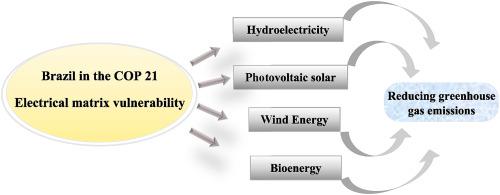Environmental Development ( IF 4.7 ) Pub Date : 2020-02-13 , DOI: 10.1016/j.envdev.2020.100504 M.A. Lima , L.F.R. Mendes , G.A. Mothé , F.G. Linhares , M.P.P. de Castro , M.G. da Silva , M.S. Sthel

|
The COP 21 (21st Conference of Parties) held in 2015, in Paris, proposed to limit the average global temperature increase at a maximum of 2 °C. Brazil has programs for reducing GHGs through Intended Nationally Determined Contributions (INDC) in the energy sector. Between 2012 and 2015 Brazil faced a drastic reduction in rainfall volumes which led to a decrease in hydroelectric generation, then offset by thermoelectric generation, with an increase in its emissions. The objective herein is to review the expansion in the use of renewable energy sources to meet the INDC's goals, given the future vulnerability of the Brazilian electricity matrix. The use of renewable energy such as wind, solar and co-generation for electric production has grown considerably in Brazil. The growth of wind power generation was a result of the investment initiated by these public policies to promote the Brazilian wind industry through the Programme of Incentives for Alternative Electricity Sources (PROINFA), the increase of wind generation in both South and Northeast subsystems. Wind energy is aimed to reach 20 GW of electricity production by 2024. The public and private initiatives in the solar energy segment reflect, first and foremost, upon the creation of a solar photovoltaic industry in the country and, from there, a consequent expansion of this energy's usage. The cogeneration processes have contributed to industries in a positive way, both in supplying electricity for internal energy plants' demands as well as those of the national electric system. Therefore, the diversification of the energy matrix is a goal to be achieved. The use of new renewable energy sources and the maintenance of investments in hydropower are part of the Brazilian strategy to turn its electric matrix less vulnerable climate change consequences..
中文翻译:

可再生能源减少温室气体排放:实现巴西《巴黎协定》的目标
COP 21(21日于2015年在巴黎举行的缔约方大会建议将全球平均温度上升限制在最高2°C。巴西制定了通过在能源领域进行国家自主贡献(INDC)减少温室气体的计划。在2012年至2015年之间,巴西的降雨量急剧减少,导致水力发电量减少,然后被热力发电抵消,其排放量增加。鉴于巴西电力矩阵的未来脆弱性,本文的目的是审查可再生能源的使用扩展,以实现INDC的目标。在巴西,将风能,太阳能和热电联产等可再生能源用于电力生产的情况已大大增加。风力发电量的增长是这些公共政策所发起的投资的结果,这些政策通过《替代能源激励计划》(PROINFA)促进了巴西的风力发电业,南亚和东北亚子系统的风力发电量均有所增加。到2024年,风能的目标是达到20吉瓦的发电量。太阳能领域的公共和私人计划首先反映出该国创建太阳能光伏产业并由此扩展了该产业的发展。这种能量的使用。热电联产过程为工业发展做出了积极的贡献,既满足了内部能源厂的需求,也满足了国家电力系统的需求。因此,能量矩阵的多样化是要实现的目标。使用新的可再生能源和维持对水电的投资是巴西战略的一部分,该战略旨在改变其电力矩阵对气候变化的影响。











































 京公网安备 11010802027423号
京公网安备 11010802027423号